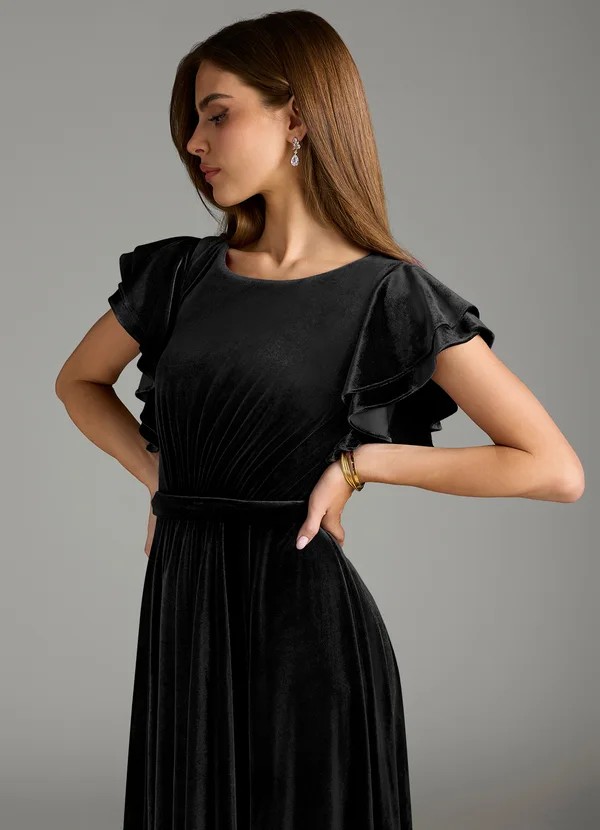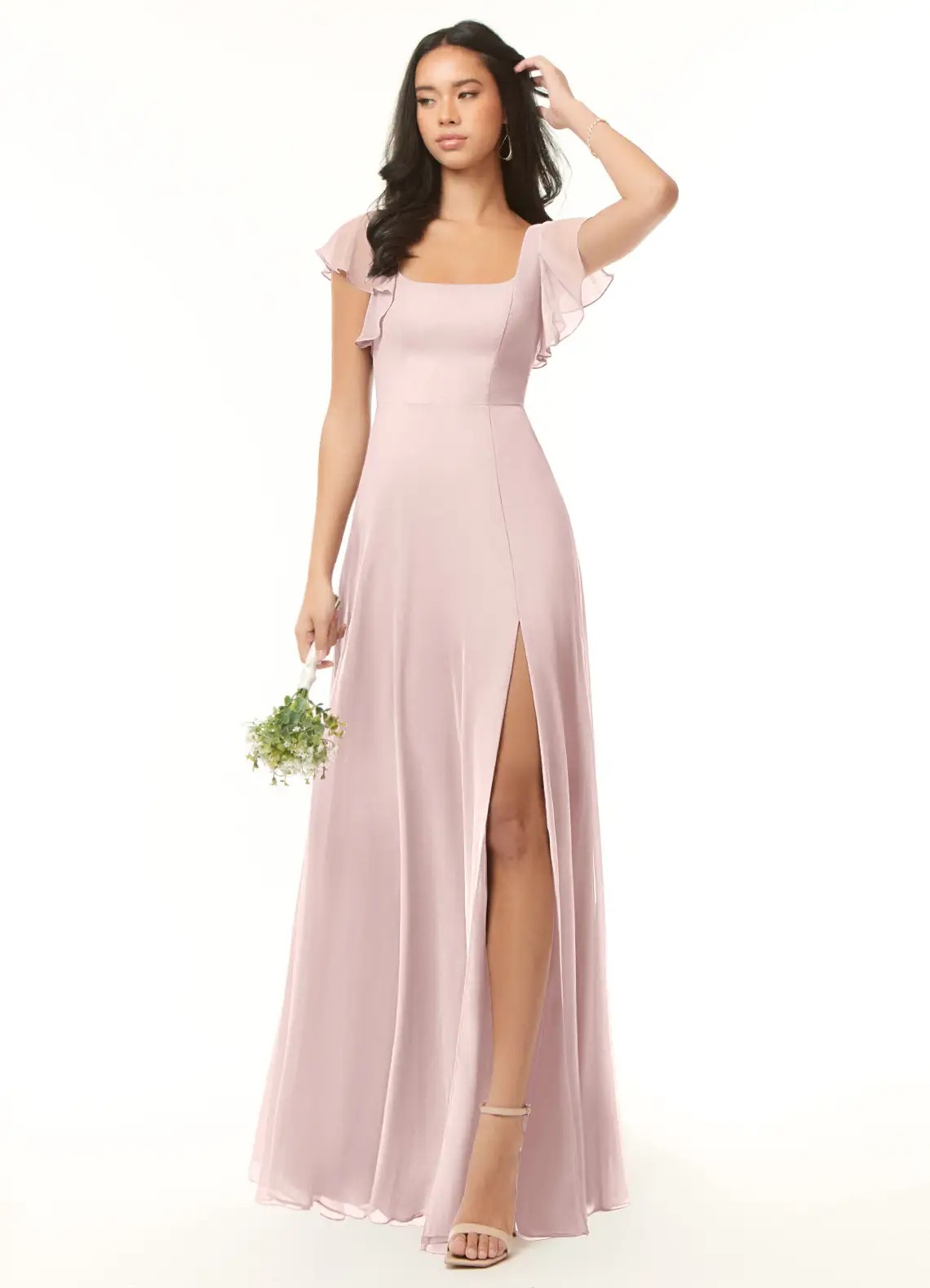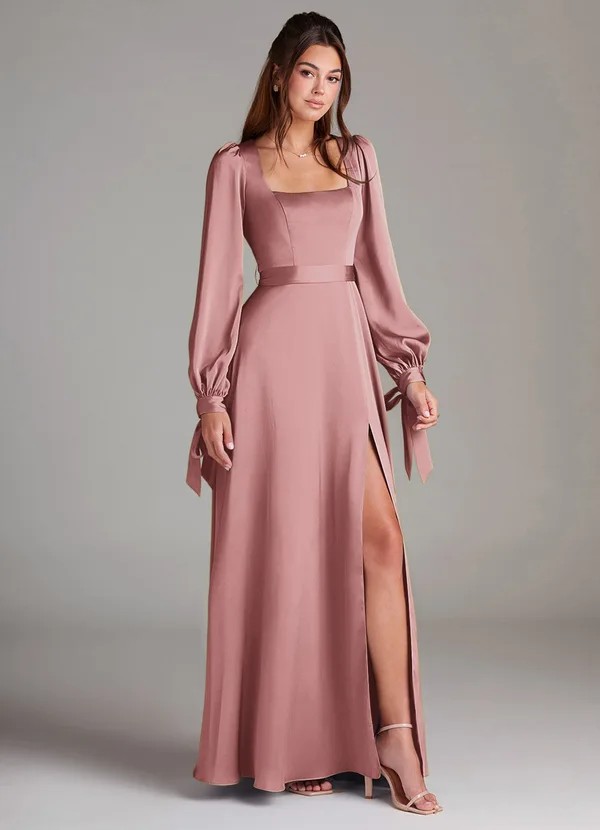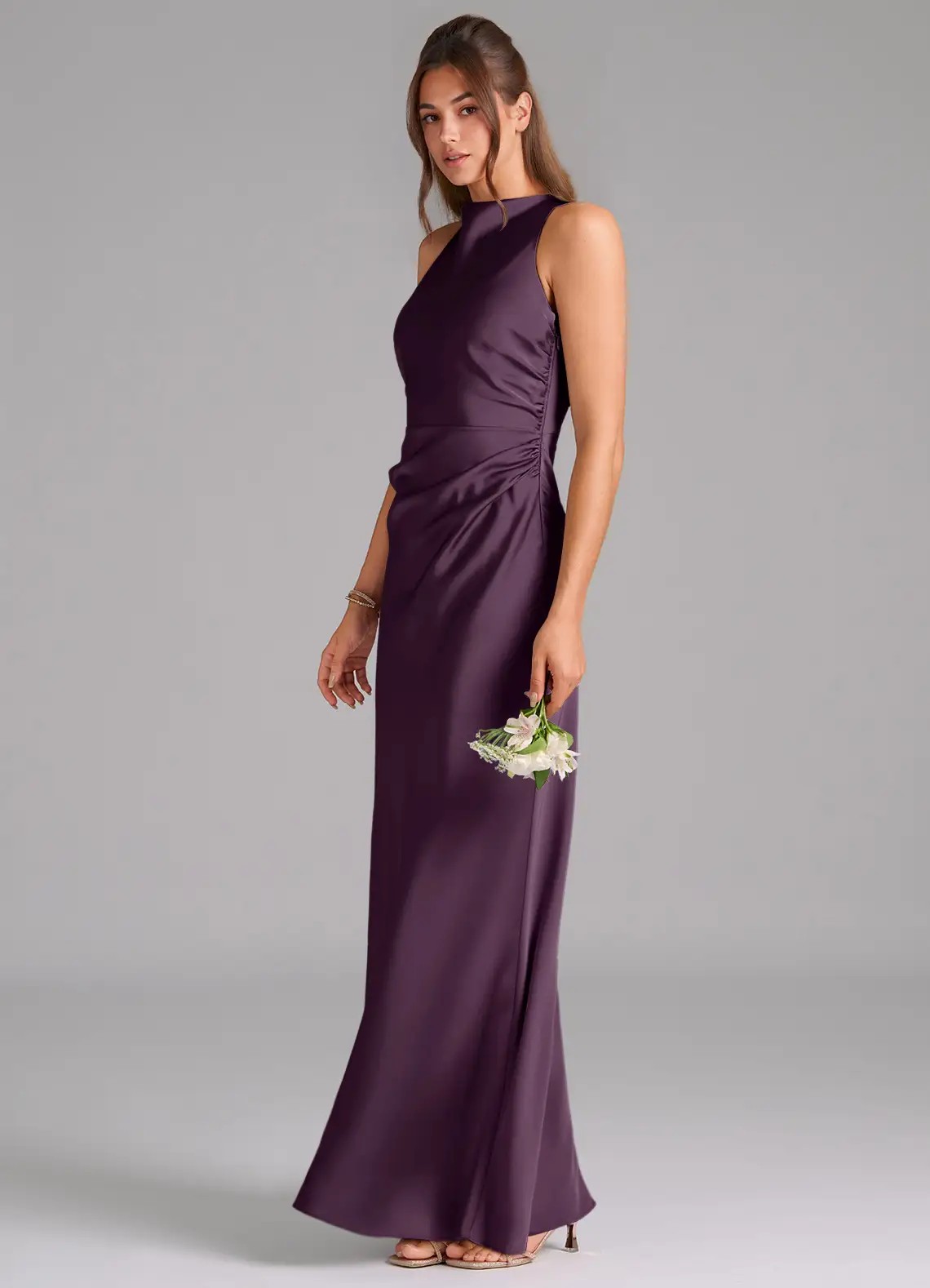How Do I Choose a Bridesmaid Dress for a Wedding with a Specific Color Theme?

Order fabric swatches in your chosen colors and view them in natural light at your venue. Match bridesmaid dress colors to your wedding palette by selecting shades that complement your flowers, season, and venue décor.
Order all dresses from the same dye lot within 2–3 weeks to ensure color consistency. Allow 4–6 months before your wedding for production and alterations.
Use the 60-30-10 color rule: 60% primary color, 30% secondary color, 10% accent color across your entire wedding.
Steps to Match Bridesmaid Dresses to Your Color Theme
Step 1: Define Your Complete Wedding Palette
Choose 3–5 colors total for your wedding. Select one primary color for bridesmaid dresses.
Add 2–3 complementary colors for flowers, décor, and accents. Write down exact color names from fabric swatches, not just “blue” or “pink.”
Step 2: Order Physical Fabric Swatches
Never trust screen colors—order physical swatches in 3–5 shades near your target color. Compare swatches against your venue photos, floral samples, and other décor.
View swatches in natural daylight, indoor lighting, and evening light. Colors look different under various lighting conditions.
Step 3: Consider Your Venue and Season
Match colors to your venue’s existing palette and natural surroundings. Garden venues work well with sage, dusty rose, and soft pastels.
Ballrooms suit jewel tones like emerald, burgundy, and navy. Beach settings pair with champagne, dusty blue, and coral.
Step 4: Test Colors Against Skin Tones
Bring swatches to a bridesmaid gathering and hold them near faces. Some colors flatter certain skin tones better than others.
Choose universally flattering shades or offer 2–3 color options within your palette. Dusty rose, sage, and dusty blue work for most skin tones.
Step 5: Order All Dresses Together
Place all bridesmaid dress orders within 2–3 weeks using the same color name and code. Dye lots vary between production runs—ordering together ensures matching shades.
Confirm the exact color code with your retailer. Save the dye lot number for any future orders.
Color Matching by Wedding Theme
| Theme | Primary Colors | Secondary Colors | Accent Colors | Best Fabrics |
| Classic/Traditional | Blush, Champagne, Navy | Ivory, Gold, Silver | White, Cream | Satin, Chiffon |
| Romantic Garden | Dusty Rose, Sage, Lavender | Blush, Mauve, Soft Pink | Gold, Cream | Chiffon, Tulle |
| Beach/Coastal | Dusty Blue, Aqua, Coral | Sand, Ivory, Seafoam | White, Gold | Chiffon, Organza |
| Rustic/Barn | Burgundy, Terracotta, Olive | Cream, Taupe, Brown | Copper, Wood tones | Lace, Mesh |
| Modern/Minimalist | Black, Grey, Navy | White, Charcoal, Taupe | Silver, Clear | Satin, Crepe |
| Bohemian | Terracotta, Mustard, Rust | Sage, Cream, Burnt Orange | Gold, Natural | Lace, Chiffon |
| Winter Formal | Emerald, Burgundy, Navy | Silver, Gold, Plum | White, Ice Blue | Velvet, Satin |
Color Coordination Strategies

Monochromatic (One Color Family):
- All bridesmaids wear the same color in different shades
- Example: Light pink, medium pink, dusty rose, mauve
- Creates an ombré or gradient effect
- Works well for 4–6 bridesmaids
Complementary (Opposite Colors):
- Use colors opposite on the color wheel
- Example: Blue and orange, purple and yellow
- Creates bold, vibrant contrast
- Best for modern or eclectic weddings
Analogous (Adjacent Colors):
- Choose 2–3 colors next to each other on the wheel
- Example: Blue, teal, and green
- Creates harmonious, cohesive look
- Ideal for garden and beach themes
Neutral + Accent:
- Neutral base (champagne, taupe, grey) with bright accents
- Example: Grey dresses with coral bouquets
- Sophisticated and versatile
- Works for any venue or season
Seasonal Color Guide
Spring Weddings (March–May):
Best Colors:
- Blush pink
- Lavender
- Sage green
- Soft yellow
- Light coral
Why They Work: Reflect blooming flowers and fresh growth
Fabric Pairing: Chiffon, tulle, lightweight satin
Summer Weddings (June–August):
Best Colors:
- Dusty blue
- Champagne
- Coral
- Aqua
- Sunny yellow
Why They Work: Bright, airy, photograph well in natural light
Fabric Pairing: Chiffon, organza, lightweight mesh
Fall Weddings (September–November):
Best Colors:
- Burgundy
- Terracotta
- Olive green
- Burnt orange
- Plum
Why They Work: Match autumn foliage and harvest tones
Fabric Pairing: Velvet, satin, heavier chiffon
Winter Weddings (December–February):
Best Colors:
- Emerald green
- Navy blue
- Burgundy
- Silver grey
- Deep plum
Why They Work: Rich, jewel tones create warmth and elegance
Fabric Pairing: Velvet, satin, structured fabrics
Venue-Specific Color Selection

| Venue Type | Colors to Choose | Colors to Avoid | Why |
| Garden/Outdoor | Sage, blush, lavender, dusty blue | Bright neon, stark white | Compete with natural colors |
| Beach | Champagne, aqua, coral, sand | Dark burgundy, black | Too heavy for light setting |
| Ballroom | Emerald, navy, burgundy, gold | Pastels that wash out | Need richness for formal space |
| Barn/Rustic | Terracotta, olive, rust, taupe | Bright jewel tones | Clash with wood and natural textures |
| Church | Navy, burgundy, dusty rose, sage | Neon, overly casual colors | Respect traditional setting |
| Rooftop | Grey, dusty blue, champagne, blush | Colors matching city skyline | May blend into background |
Testing Colors in Different Lighting
Natural Daylight Test:
- Hold swatches outdoors between 10 AM–2 PM
- Check how sunlight affects shade intensity
- Colors appear truest in natural light
- Take photos to compare later
Indoor Venue Lighting:
- Visit venue and view swatches under their lighting
- Ballroom lights may add yellow or blue tones
- Check both ceremony and reception spaces
- Note difference between day and evening lighting
Evening/Candlelight:
- Test swatches in dim lighting and candlelight
- Some colors darken significantly
- Lighter shades photograph better in low light
- Metallics and jewel tones shine in evening settings
Color Matching with Wedding Elements

Matching Flowers:
- Bring flower samples or photos when selecting dress colors
- Dresses should complement, not match exactly
- Use flowers as accent, dresses as base
- Contrast creates visual interest
Matching Venue Décor:
- Request venue photos showing wall colors and lighting
- Avoid colors that blend into walls or carpet
- Choose colors that pop against venue backdrop
- Consider fixed elements like curtains and upholstery
Matching Groomsmen Attire:
- Coordinate tie or vest color with bridesmaid dresses
- Suits typically stay neutral (black, grey, navy)
- Accessories tie the wedding party together
- Use same color family for cohesion
Common Color Challenges and Solutions
| Challenge | Problem | Solution |
| Dye lot variation | Dresses ordered separately don’t match | Order all within 2–3 weeks from same lot |
| Screen vs. reality | Online colors look different in person | Always order physical swatches first |
| Unflattering tones | Color doesn’t suit all skin tones | Offer 2–3 shades in same color family |
| Venue clash | Dress color fights with venue walls | Visit venue with swatches before deciding |
| Seasonal mismatch | Winter colors at summer wedding | Choose season-appropriate shades |
| Photography issues | Colors wash out or darken in photos | Test with venue photographer or sample shots |
Skin Tone Considerations

Warm Skin Tones (Golden, Peachy Undertones):
Flattering Colors:
- Coral
- Terracotta
- Olive green
- Burnt orange
- Gold champagne
Colors to Approach Carefully: Cool blues, icy pastels
Cool Skin Tones (Pink, Blue Undertones):
Flattering Colors:
- Dusty blue
- Lavender
- Emerald
- Navy
- Burgundy
Colors to Approach Carefully: Warm oranges, yellows
Neutral Skin Tones (Balanced Undertones):
Flattering Colors:
- Most colors work well
- Dusty rose
- Sage
- Champagne
- Mauve
Universal Options: These shades flatter everyone
Mixing Patterns and Solids
When to Mix:
- Modern, eclectic, or bohemian themes
- Garden weddings with floral prints
- When you want visual variety
How to Mix Successfully:
- Keep color family consistent
- Use same fabric type
- Maintain identical length
- Limit patterns to 1–2 dresses in group
Best Pattern Options:
- Floral prints for garden themes
- Subtle geometric for modern weddings
- Lace overlays for romantic styles
Color Trends by Year
Current Popular Combinations:
- Sage green + terracotta + cream
- Dusty blue + champagne + gold
- Burgundy + blush + ivory
- Navy + dusty rose + grey
- Emerald + gold + ivory
Timeless Classic Combinations:
- Blush + champagne + gold
- Navy + ivory + silver
- Burgundy + ivory + gold
- Sage + ivory + natural wood tones
Frequently Asked Questions
Should bridesmaid dresses match or complement my wedding colors?
Bridesmaid dresses should complement, not exactly match your décor. Use dresses as your base color and flowers or accessories as accents.
Exact matches often look forced and limit your color options. Complementary colors create depth and visual interest in photos.
How do I ensure all bridesmaid dresses are the same color?
Order all dresses within 2–3 weeks using the exact same color name and code. Request the same dye lot number for consistency.
Even small delays can result in different production batches. Save the dye lot information for any late additions or replacements.
Can I mix different shades of the same color?
Yes, mixing shades creates a beautiful ombré or gradient effect. Choose 3–5 shades from the same color family arranged from light to dark.
Order swatches to ensure shades coordinate well together. This works best with 4–6 bridesmaids for visual impact.
What if my bridesmaids can’t agree on a color?
Choose one neutral base color and let bridesmaids select their own style or add personal accessories. Alternatively, offer 2–3 pre-approved shades within your color palette.
Keep fabric and length consistent for cohesion. Test the combination with photos before final decisions.
How far in advance should I choose my color?
Select your color theme 8–10 months before the wedding. This allows time for swatches, bridesmaid input, and dress ordering.
Order dresses 4–6 months before the wedding for production and alterations. Rush orders may limit color availability.
Do metallic colors work for bridesmaid dresses?
Yes, metallic colors like gold, champagne, rose gold, and silver work beautifully for formal weddings. They photograph well and add elegance.
Metallic shades look different under various lighting—test thoroughly. They work for any season and pair with most color palettes.
Key Takeaways
Order physical fabric swatches and test them in your venue’s natural and artificial lighting before making final decisions. Colors appear different on screens versus in person.
Order all bridesmaid dresses within 2–3 weeks using the same color code and dye lot number. This ensures perfect color matching across all dresses.
Choose colors that complement your season, venue, and skin tones. Use the 60-30-10 rule: 60% primary dress color, 30% secondary flowers/décor, 10% accent details.
Allow 4–6 months for ordering and alterations. Start your color selection process 8–10 months before your wedding date.